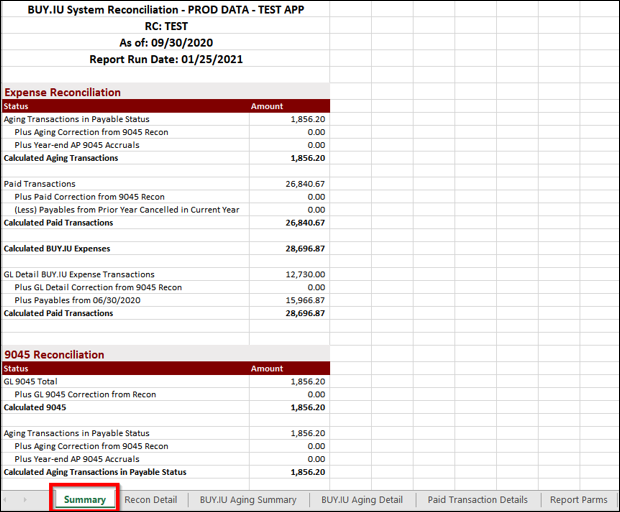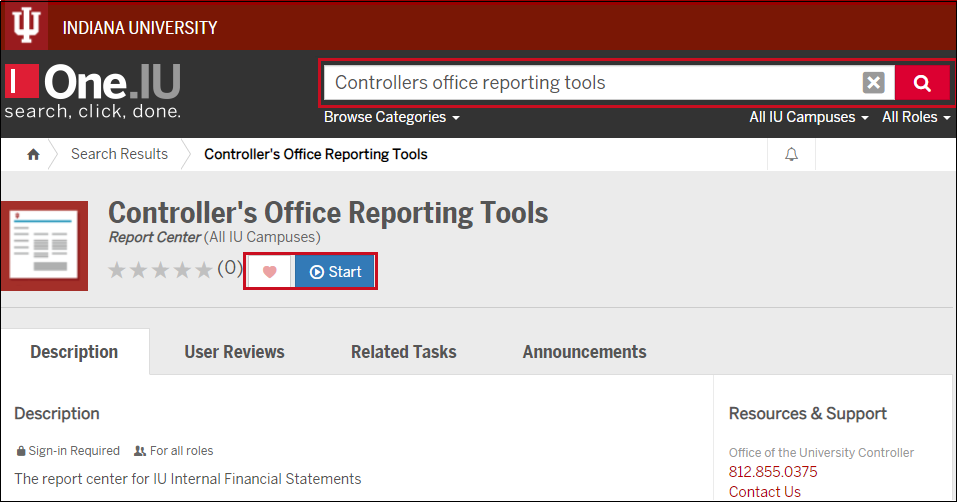Prerequisites
Prior to reading the instructions on the BUY.IU financial statement report, it is beneficial to review the following sections of the IU Accounting Standards:
- Accounting Fundamentals Pressbook
- Chart of Accounts and General Ledger Pressbook
- Financial Statement Pressbook
- BUY.IU Year-End AP Accrual Detail Instructions
- BUY.IU Aging Report Instructions
- BUY.IU Paid Transactions Instructions
Overview
BUY.IU is Indiana University’s procurement system which was introduced in Fiscal Year 2020. The Office of the University Controller developed the BUY.IU Financial Reports to assist users with the reconciliation, analysis, and identification of errors. BUY.IU Financial Reports analysis helps fiscal officers and executive leadership assess overall spending, ensure payments are made in a timely manner and provides supporting documentation for the main financial statements. This compilation of reports generates three reports simultaneously; the BUY.IU Aging Report, the BUY.IU Paid Transactions Report, and the Departmental 9045 Reconciliation Report then summarizes the reconciliation of expenses and liabilities. Users are encouraged to pull the BUY.IU Financial Reports in verse of each individual report as most quarterly and year-end close procedures require all three reports to be pulled.
Understanding the BUY.IU Financial Reports
It is important to note that the BUY.IU Financial Reports do not include all expenses but only those processed through BUY.IU, i.e. an invoice must be entered into the system. Expenses such as salaries and wages or cash are not included. The BUY.IU Financial Reports has the As of Date and Run Date highlighted in the header of the reports. The As of Date is the date specified in the parameters and shows the cut-off date of the information provided while the Run Date is the date the report was generated. Note: Unlike document searches in BUY.IU that return real-time search results, data in the reporting application is updated nightly, therefore, report data is always one day in arrears. It is important users understand the as of date parameter returns the previous day’s data if a specific data is not entered.
The BUY.IU Financial Reports compilation is comprised of the four BUY.IU reports and is organized in the following seven tabs:
- Summary Tab: The initial tab is the reconciliation of the BUY.IU data to the General Ledger. The summary tab reconciles all four reports against one another to ensure accuracy of data throughout the report and helps pinpoint issues within a specific report.
- Recon Detail (9045 Reconciliation Report): The Recon Detail tab provides a side-by-side comparison of invoices with their corresponding statuses in BUY.IU, the General Ledger, and any corresponding corrections. This information identifies reconciliation errors between the various systems. The year-end accrual details are also included in this tab. The accruals are for all accounts payable invoices that were included in the automatic Accounts Payable accrual process. This information assists users in determining if all material expenses have been properly recorded. The accrual lines include information such as BUY.IU invoice number, transaction ledger entry description and date along with the total of the accrual. An individual BUY.IU Year-End AP Accrual Detail report is available for users who wish to just view the accruals separately.
- Out of Balance Transactions: The Out of Balance Transactions tab only displays transactions with reconciliation errors, but the transactions detail found on the Recon Detail is replicated in this tab. This tab will not appear within the BUY.IU Financial Reports if reconciliation errors do not exist.
- BUY.IU Aging Summary: The Summary Aging shows the condensed version of all outstanding invoices that have not been paid as of the date specified in the report parameters. This tab displays the payable information in aging buckets ranging from less than 30 days to over 90 days, and breaks out the invoices by status, volume of transactions and invoice amount.
- BUY.IU Aging Detail: The Aging Detail shows all invoices outstanding that have not been paid as of the date specified in the report parameters. This tab shows invoices at an individual level with more detail on the specifics of the invoice, how it is recorded, and similarly, presents the amounts due in aging buckets. The tab also includes direct links to the BUY.IU invoice.
- Paid Transactions Details: The Paid Transactions Detail tab shows all invoices paid through the date specified in the report parameters. The tab includes information such as supplier invoice number (#), quantity, payment disbursement date and specific information on how the invoice was recorded.
- Report Parms: Summarizes the parameters selected on the report parameter page within the Controller’s Office Reporting Tools app, including as of date, chart code, and account information. Since BUY.IU searches retrieve real-time data, it is important to remember reports produced in the Controller’s Office Reporting Tool are one day in arrears. The reporting tool uses data stored in the DSS tables, which are updated nightly. BUY.IU Financial Reports with an as of date parameter set equal to the current date will not match BUY.IU search results for the current date.
Note: Each individual tab includes a subtotal function which is included in the reconciliation on the summary tab. An example of BUY.IU Financial Report is included below for reference, showing all tabs within the report.

The BUY.IU Financial reports can be accessed from this page - refer to the top right blue button labeled "Go to Report" which will automatically redirect users to the report within the Controller’s Office Reporting Tools.
In addition, the report can be found in One.IU.To find the report, search for “Controller’s Office Reporting Tools” in the search bar, and select Controller’s Office Reporting Tools (Report Center) in the drop down menu. Mark this task as a favorite by clicking the heart icon next to the start button and then select Start or click on the title.

Once in the Controller’s Toolkit, users will see all available reporting tiles. Navigate to the Other Standard Reports and Compilations folder. A new tile opens, which displays all the available reports. Select BUY.IU Financial Reports.

Running the Report
Define the search parameters to return results relevant to your organization or to a specific account. The search parameters available in the BUY.IU Financial Reports are divided into three parameter types: chart of account report parameters, report specific parameters and display parameters.
If there are questions related to running the report, requirements or reviewing results, please contact your (RC) fiscal officer or campus office. Each campus may have individual specific requirements related to the BUY.IU Financial Report, be sure to reach out to the related campus office or fiscal officer prior to quarter closings.
General Notes: Do not include any special characters other than approved wildcards in any of the below parameters. Additionally, do not run reports by campus as it will take up valuable computing services.
Several parameters are available to assist users. Users can enter the responsibility center (RC) code, organization code, and account number(s) for their respective organization. In order to prevent long run times, users are required to enter at least one Chart of Accounts Parameter in conjunction with any other parameter, i.e. As of Date and Organization Code or Account Number and BUY.IU Invoice Number.
If unsure, several of the parameters have a valid values function which displays the available codes and corresponding descriptions.
| Parameter | Description |
|---|---|
| University Fiscal Year | Used to limit report to a specific fiscal year(s). |
| As of Date | By entering in an ‘As of Date’ users should be able to reconcile back to their financial statements |
| Chart of Accounts | Used to limit report to one or more specific chart of accounts. For assistance determining your chart code, refer to KFS chart report. |
| Responsibility Center Code | Used to limit to a specific RC. Users are encouraged to use this parameter in conjunction with a chart of accounts code. For assistance determining your RC code, refer to KFS RC report. |
| Organization Code | Used to limit report to a specific organization code. Users are encouraged to use this parameter in conjunction with a chart of accounts code. At this time, Buy.IU is not configured to allow organizational hierarchy reporting. For example, if the user entered BA-RPAS the report would not return any results. In order to see all of the data for BA-RPAS, the user would need to enter all of the individual organizations. However, a user can save the parameter set (with all of the individual organizations) for the next time they need to run the report to avoid having to rekey them each time. |
| Account Number | Used to limit report to one or more specific account(s). |
| Sub-Account Number | Used to limit report to one or more specific sub-account(s). |
A report specific parameter is a parameter that is limited to a single or small group of reports. For example, on the BUY.IU Financial Reports users would expect to see an invoice number, but that is not going to be applicable on most other reports. For the BUY.IU financial report, it is split into BUY.IU Aging, BUY.IU Paid Transactions Report and Department 9045 Reconciliation Report specific parameters, but most report parameters remain the same between individual reports.
| Parameter | Description |
|---|---|
| BUY.IU Invoice Number | By entering a single BUY.IU Invoice Number, the user would be able to identify the invoice type and the invoice status. Note: If the invoice has been paid, it will not appear on the BUY.IU Aging Report. |
Display parameters are parameters that define and restrict the visual presentation of the BUY.IU Financial Report. They are found on the lower part of the parameters.
| Parameter | Description |
|---|---|
| Include Subtotals | Check/Uncheck - If the user selects clicks on include subtotaling, the report will insert a subtotal at the account level. |
| Include Hyperlinks in Excel Output | Check/Uncheck – If the user checks include hyperlinks in excel output, the report will include links within the excel version and the user will have the ability to drill down for additional detail. Note: When using this parameter, user may need to click the “Enable Editing” button in the Excel report output in order to display dollar amounts. |
Click Save Parameter Settings to save your parameters for future use of this report. For instructions on how to save settings, review the Save Parameter Settings document on the Controller’s Office Reporting Tools page.